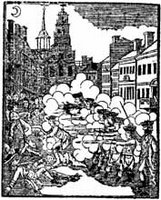The Last Victim of the Boston Massacre?
 Three people died very quickly after the shooting on King Street that we’ve come to call the Boston Massacre: Crispus Attucks, Samuel Gray, and James Caldwell. The apprentice Samuel Maverick died before daylight.
Three people died very quickly after the shooting on King Street that we’ve come to call the Boston Massacre: Crispus Attucks, Samuel Gray, and James Caldwell. The apprentice Samuel Maverick died before daylight.
Bostonians expected two more wounded teenagers to die soon afterwards. The Boston Gazette for 12 Mar 1770 listed them as:
A lad named Christopher Monk, about 17 years of age, an apprentice to Mr. [Thomas] Walker, Shipwright; wounded, a ball entered his back about 4 inches above the left kidney, near the spine, and was cut out of the breast on the same side; apprehended he will die.Of course, it is apprehended that we all will die, but the Boston Whigs were clearly not expecting to see these teens around for much longer.
A lad named John Clark, about 17 years of age, whose parents live at Medford, and an apprentice to Capt. Samuel Howard of this town; wounded, a ball entered just above his groin and came out at his hip, on the opposite side, apprehended he will die.
Instead, the next person to die of his wounds was the breeches-maker Patrick Carr. That brought the number of deaths to five, which is the total that usually appears in history books.
When Henry Pelham created his engraving of the Massacre (the model for Paul Revere’s more famous one, as well as the little version shown above), his caption named all five men who had died and added: “Six others were wounded; two of them, mortally.” The town was still waiting for Monk and Clark to die.
And the waiting went on. As I described earlier in the week, in early 1774 Monk’s master went to Boston and asked for public assistance because the boy was still alive, but still languishing—and shortly to turn twenty-one. The selectmen collected private contributions for Monk and doled them out over the following year.
And still Monk survived. Officials also collected donations for him after the Massacre orations of 1775 and 1777. (The 1776 oration took place outside Boston.) I assume there were collections in the next two years as well, and in 1780 newspapers once again reported that “A collection was made for the unhappy Monk, who still languishes under the cruel wounds he received.” The town records for that year report:
Mr. [John] Scollay Reported that he had distributed the whole of the Money Collected March 6. 1780 for Christopher Monk as p[er] Minute Book of that date—the Sum being three hundred thirty two pounds fourteen Shillings & 1d. Old Money—the particulars of which he exhibited to the Selectmen—But on 20 Apr 1780 the Continental Journal ran this notice:
Died. Mr. CHRISTOPHER MONK, who has been long languishing under the wounds he receiv’d on the evening of the fifth of March, 1770, by a party of British mercenaries, under the command of Capt Thomas Preston. His funeral will be attended this afternoon.Monk would have been about twenty-seven years old. His wound in 1770 appears to have been debilitating, and quite possibly led to his early death. By some standards, we should list Monk as the sixth fatal victim of the Boston Massacre. But we don’t.
(According to Ellen Chase’s The Beginnings of the American Revolution (1910), John Clark had died in 1778. I don’t know the source of that statement. It might be based on an incomplete peek at Medford’s vital records, which state that a John Clark died in that town on 26 May 1778—but he was sixty years old. Those same town records say that John Clark, Jr., was born there on 10 June 1752, so he was indeed seventeen years old when wounded.)

1 comment:
Atom,
What happened to Atwood and Clark? I know that John(son of Samuel) Atwood has a painting of him and his family at the Boston M. of Art. Did Clark fall off the face of the Earth? Did he become a recruiter for the Minute men? People had to have made these two heroes in 1770. Maybe Clark had to change his name? Hollister? They may just be lost to time.
Tommy Neumann
tommyneumann@me.com
Post a Comment